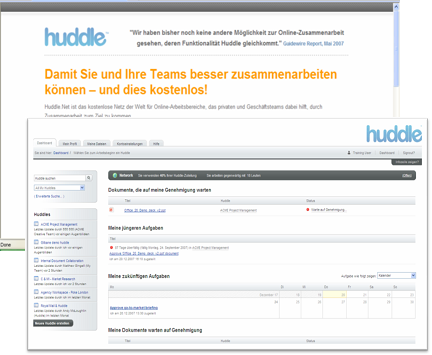Mediasurface (UK, AIM: MSR) announced a new extension to its Morello web content management solution that adds benefits to allowing enterprise users to work together on content creation using MOSS 2007. The new Morello MOSS 2007 Connector makes it easier and quicker to find, organise and publish MOSS generated content through an enterprise web delivery infrastructure on one or more websites, intranets and extranets. Mediasurface addresses this with the new Morello MOSS Connector which integrates MOSS tools with Mediasurface’s Morello enterprise web content management solution. Automated processes keep information synchronized, ensuring that websites always display the very latest, approved version of a document whilst SharePoint users will always have direct access to information captured on the websites. In addition, the Morello MOSS 2007 Connector plugs into the generally available standard collaboration and communication services of SharePoint (called WSS), so there is no technical setup required. Users can collaborate, create and review documents, images and pages using familiar tools such as MS Word and Outlook. The connection to Morello helps ensure users know which MOSS generated content is approved for use, avoiding duplication and speeding up the publishing cycle. http://www.mediasurface.com
Category: Collaboration and workplace (Page 52 of 98)
This category is focused on enterprise / workplace collaboration tools and strategies, including office suites, intranets, knowledge management, and enterprise adoption of social networking tools and approaches.
A: When its a huddle.
Q: When is a huddle an environment for multilingual communication?
A: When a huddlee can dynamically change the user interface to work in her native language.
Q: Why is this interesting?
A: Because we’ve yet to see a concentrated focus on globalization requirements in the social computing and collaboration space. In fact, we’ve been wondering where is the “L” is in Web 2.0?
Q: What if you don’t speak German?
A: The company that built and manages the huddle concept (Ninian Solutions Ltd) provides a French user interface as well and according to our interview with the company, Spanish, Chinese, and Japanese will follow.
Q: So how will content created by huddlers get translated?
A: Machine translation may very well prove its use within a Web 2.0 environment. Stay tuned.
Gilbane Group Inc. announced they have seven research studies underway that will be published over the next few months. The research for some of these studies is already complete, and preliminary results will be discussed at this week’s Gilbane Boston conference at the Westin Copley Place Hotel. The 7 studies are: “Survey on the Web Content Management User Experience” – From our Web Content Management Practice, led by Tony White; “Enterprise Collaboration and Social Computing: A Report on Industry Trends & Best Practices” – From our Social Computing and Collaboration Practice, led by Geoffrey Bock; “Digital Magazine & Newspaper Editions: Growth, Trends, and Best Practices” – From our Cross Media Publishing Strategy & Technology Practice led by Steve Paxhia; “Enterprise Search Markets and Applications: Capitalizing on Emerging Demand” – From our Enterprise Search Practice, led by Lynda Moulton; “Enterprise Digital Rights Management: Business Imperatives and Implementation Readiness” – From our Cross Media Publishing Strategy & Technology Practice, study led by Bill Rosenblatt; “Digital Platforms & Technologies for Book Publishers: Implementations Beyond ‘eBook'” – From our Cross Media Publishing Strategy & Technology Practice led by Steve Paxhia; and “Beyond Search: What to do When you’re Enterprise Search System Doesn’t Work” – A study authored by Steve Arnold, from our Enterprise Search Practice, led by Lynda Moulton. https://gilbane.com
The theme for the opening keynote panel: Content Technologies – What’s Current & What’s Coming? at our Boston conference this week is: change – and what it means for content and information management strategies.
Of course there is constant and rapid change in technology, but we are now entering an era of multiple tectonic shifts that will challenge IT and business strategists more than ever. And the changes are not all technological, even if largely caused or influenced by technology. For example, the computer-literate generation entering the workplace, consumer technology changing expectations in the workplace, and a sometimes desperate need to adjust or completely change business models.
Other fundamental changes affecting enterprise information management strategies include the speeding freight trains of mobile computing, cloud computing, enterprise software consolidation, and global e-commerce markets.
We’ll also take a look at some specific technologies and ideas that are often over-hyped or not well-understood. Many of these have an important role to play in enterprise information strategies, and the panel’s goal will be to help you think through what your expectations of them should be. Examples include technologies that go ‘beyond search’, social software networks, user-generated content, tagging, enterprise blogs and wikis, and e-books.
This is a lot to cover in an interactive 90 minutes, but our panel will certainly get you thinking, and provide some perspective for your discussions with other attendees, speakers, and exhibitors. Joining me on the panel are:
- Andrew P. McAfee, Associate Professor of Business Administration, Harvard Business School
- David Mendels, Senior Vice President, Enterprise & Developer Solutions Business Unit, Adobe
- Andy MacMillan, Vice President, ECM Product Management, Oracle
- David Boloker, CTO Emerging Internet Technology, Distinguished Engineer, IBM Software Group
Saul Hansell has a tantalizing tidbit in today’s NYTimes, a report that Yahoo! and Google are thinking about making their email systems ‘more social.’ “Web-based email systems already contain much of what Facebook calls the social graph — the connections between people. That’s why social networks offer to import the e-mail address books of new users to jump-start their list of friends.” Our personal email applications should keep track of who is most important to us, and let us know when those messages arrive.
Saul’s report opens Pandora’s box about the future of Enterprise 2.0. The dirty little secret is that our e-mail in-boxes track our social networks by default — who we communicate with, when and in what order can be as interesting as what in fact we say (or do not say). Our personal address books are more than a random list of names — they’re the ‘black books’ that contain the people with whom we’ve exchanged messages in the past, or want to communicate with in the future.
We intuitively track our business networks through our use of email — the names of folders we use when filing messages, the subjects we attach to messages, and the threads of a back-and-forth discussion are all grist for the social networking mill. Gmail, for example, collects message threads into a single record. This is a handy innovation, which helps to cut down on the message clutter that’s so prevalent in Notes Mail & Outlook.
The real challenge is that messaging inside the enterprise is frozen in time — captured by the two most widely deployed messaging applications, from Microsoft (Outlook/Exchange) and IBM (Lotus Notes). It’s hard to believe that these are legacy platforms.
We need to rethink what else we can do with email inside the enterprise — Lotus Connections goes a long way towards staking out a few essential services. These include an “intelligent” enterprise directory & a tag cloud that relates to communities within the enterprise.
We need to do a lot more with features around privacy, security, organizational boundaries, and context.
Note: You can now view a recording of the Webinar on SharePoint and ECM.
I wrote a couple of days ago about the growth of SharePoint licensing and the impressive footprint it has in terms of end user licenses. One of the other intriguing things about SharePoint is how it has evolved in functionality. True to form, Microsoft first launched SharePoint as a sturdy but not overwhelming offering. Since then, they have built more and more functionality into the product, all the while bringing partners and developers into the mix to create a formidable ecosystem for the product.
MuseGlobal announced the adoption of its content integration platform by Microsoft’s SharePoint Server 2007 enterprise suite. With Muse technology, SharePoint customers are now able to present local and licensed content to their enterprise users in a controlled and protected environment. The Microsoft Office SharePoint Server is an enterprise portal platform that makes it easy to build and maintain portal sites. Through consolidated access to existing business applications and content, companies can drive consistent performance of common business tasks, and SharePoint’s integrated Web content management capabilities enable people to publish Web content with a content authoring tool and a built-in approval process. MuseGlobal search integration and management systems enable institutions to build search products and services, unifying a wide range of content sources into custom search solutions. http://www.museglobal.com
Microsoft SharePoint is a force in the content management market. For the year ending June 2007, Microsoft reported $800 million in revenue for SharePoint, a figure that dwarfs most stand-alone ECM vendors and is nearly twice as large as Filenet’s annual revenue before it was acquired by IBM. Consider also that the other ECM vendor revenue includes substantial support dollars, and the SharePoint revenue is for licensing only. Even more impressive is the number of licenses–more than 17,000 companies have purchased 85 million licenses. That is one impressive foothold. Are all 17,000 companies using SharePoint for ECM? Of course not. Many are likely using SharePoint for basic document management and many for Web content management, and a significant number of the licenses are likely dormant or very lightly used.
Indeed, at different times in SharePoint’s product life, Microsoft has had to work hard to establish the value proposition for SharePoint to ensure enough reason for customers to renew their volume licenses. But each version of SharePoint has become more functional and has enjoyed deeper penetration into large organizations. SharePoint 2007 is now a significant ECM platform with a great deal of functionality and well established partnerships with key complementary vendors.
But the exact ways that people are using SharePoint today are not as important as the foothold it already has, and the determination organizations seem to have for making SharePoint work as a platform for myriad applications. Our discussions with users point to exactly this kind of thinking on the part of many organizations–they may have licensed SharePoint for a specific application, such as document sharing, or for a general need, but they are now looking at how the platform can support any number of other applications. This includes ECM applications, including ones with demanding scan and capture requirements.
View our recent webinar on how SharePoint is impacting the ECM market. The webinar is sponsored by KnowledgeLake.


